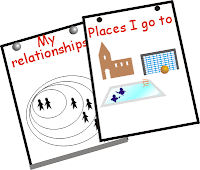A Guest Blog by Leah Weissinger
 I am a first grade teacher and do guided reading daily with my first grade students. Some of the questions posted are very appropriate for someone trying to envision how to begin, organize and plan for guided reading.
I am a first grade teacher and do guided reading daily with my first grade students. Some of the questions posted are very appropriate for someone trying to envision how to begin, organize and plan for guided reading. Pacing (getting it all in-meeting with as many groups as possible) and the management of the class are two of the most commonly asked questions about guided reading. Pacing is one of those things that you have to work on and fine tune as you work with groups year after year.
The best way to make sure you have the most efficient and effective guided reading sessions are pre planning. This takes time. Visiting your book room and spending time choosing appropriate books for your student’s guided reading level and interest is key. Sitting and looking at the books to decide your introduction (an introduction should be 2-3 min. to support the students reading and clear up unfamiliar vocabulary and read the cover discuss what the book may be about/prior knowledge of a topic/ if it is fiction or non-fiction), try to determine how the students will interact with the text, and what types of comprehension questions/discussion the text lends itself too as well as word work options. Be sure to vary genres at every level (children need experience with different publishers and genres).
If you have planned well you can call your groups quickly, be prepared with you entire lesson and move quickly to your next group (all guided reading books should go home with your students to be read again to build confidence, fluency and expression).
A guided reading session is a bit different than a conference in the respect that you are sitting back guiding as opposed to being an active member of a conversation with the student (except at the end when you discuss the story to access and even model deeper thinking), you need to listen and only prompt when it is necessary (children should be displaying independent strategies taught and self correcting as they read). If the child is at the appropriate reading level, I have found that they are making meaning as they read. You need to listen in on every child to assess throughout.
A running record can be done at different times (my thought is that you need to know the strategies they are utilizing and future teaching points for each child). I do running as often as possible (I pull a student back after a guided reading session or at other times of the day) But I do take anecdotal notes on every student during each guided reading lesson.
A onetime reading for guided reading is “ideal” because you can quickly assess, support and follow through on the book/lesson. There are plenty of great books and magazines at the higher levels that can be read in one guided reading lesson. Obviously for higher readers chapter books are a genre that need to be supported, so this can look like a literature circle (but you can use guided reading time to call these groups to meet) More advanced readers also don’t really want to reread their chapters at home-so having them read the next chapter and meet is perfectly appropriate . The students should be taking the books home as well to make reading a part of their home life. You do need to monitor reading strategies, fluency, expression and comprehension- character/ plot development and vocabulary strategies at these levels. I would just look at chapter books as a different genre. Explore some higher level one day reads (there are plenty available and you can expose these students to so many genres this way).
What level do you teach? How do you plan for your guided reading instruction?

Dear Kim and Leah,
As someone who has done hundreds of guided reading sessions over the past seven years, I feel like I can do it in my sleep, but it is always interesting to hear different viewpoints and ideas from fellow teachers. As Guided Reading is such an important part of every day, it's crucial that we continually reflect and improve our practise.
I teach Grade Two (seven/eight year olds) and I conduct one Guided Reading session per day. I have had many discussions with colleagues about whether one or two rotations per reading hour is best but I am sticking to my beliefs and will only ever do one Guided Reading session per day. I find this gives me lots of time with each group and we can complete thorough book introductions and follow up discussions.
I find that most of the books (and we have a big school so there are hundreds and hundreds to choose from) are able to be read and analysed in one session, however in higher levels I would definitely recommend spending more time on the longer books.
I never complete running records during Guided Reading sessions. I do them at other times of the day by pulling kids out of activities such as Integrated Studies. Or, I also occasionally have a Guided Reading-free week where I don't do Guided Reading and complete my running records in that time.
I also take anecodtal notes every Guided Reading session to map my students' progress.
It is essential to be well planned but I also think it's good to sometimes allow children to explore the text and allow them to guide the discussions, particularly with more competent readers.
Sometimes, instead of a follow up discussion, I will have the students complete an activity on the IWB that is connected to the focus I had for the Guided Reading text (eg. compound words, punctuation, comprehension, word decoding).
I always hear every student in my group read during Guided Reading sessions. I find that some teachers spend too long with each student, which is why they struggle to sit with every student. It's not necessary to spend huge amounts of time with everyone. You're after a snapshot of their skills. I do other conferencing etc during Independent Reading time a couple of times a week.
I think the most important thing is to use the basic structure of Guided Reading but adapt and change things to suit yourself. I hope this helps!
Kelly Jordan